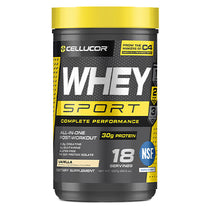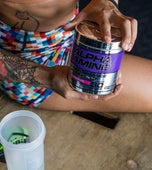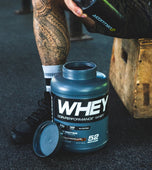
Whether you’re a serious athlete gearing up for competition, a fitness fanatic looking to break PRs, or a busy professional trying to get in your best shape ever, it’s understood that goals are achieved through hard work. The willingness to do one extra rep, set, or even workout is what separates the overachievers. What if there was something that could help support increased work volume, so you could get that extra rep in? Beta-Alanine has exploded in popularity as a performance ingredient because of its ability to help fight muscle fatigue*.
What is beta-alanine exactly and how you can use it to help build a better you?
What is Beta-Alanine?
Beta-alanine is an amino acid commonly found in meat products like beef, pork, poultry, and fish. CarnoSyn® Beta-Alanine is a patented form of beta-alanine that has been used in many of the clinical studies. CarnoSyn® is also the form of beta-alanine that you will find in all Cellucor® products containing beta-alanine.
What Does Beta-Alanine Do?
Beta-alanine combines with histidine, another amino acid, to form the dipeptide carnosine. Dipeptides are compounds consisting of two amino acids. Carnosine is found abundantly in the skeletal muscles and one of its main functions is buffering pH levels.
During exercise, hydrogen ions accumulate lowering the pH of the environment, ultimately causing muscles to fatigue. If you’ve ever experienced a burning sensation while doing lots of reps that caused you to stop, it was likely from a drop in pH.
Beta-alanine appears to be the rate-limiting step in the synthesis of carnosine.[1] In other words, carnosine production is limited by the amount of beta-alanine building blocks present in the body.

How Long Does Beta-Alanine Last In The Body?
Beta-alanine is rapidly absorbed into our bloodstream from the gut, and it gets distributed throughout the body, especially to the muscles. Different factors like the delivery form (sustained vs instant release) and our individual metabolism will impact when beta-alanine reaches peak plasma levels, but generally this occurs in about 30 minutes. And typically for most people, beta-alanine has a half-life of about 1 hour. This means that after 1 hour, half of the beta-alanine that was ingested will have been metabolized and eliminated from the body. Beta-alanine is mainly excreted from the body via urine.
Benefits of Beta-Alanine Supplementation
Research has shown that beta-alanine supplementation is an effective way to increase muscle carnosine levels, by increasing carnosine synthesis, leading to improved lactic acid buffering. When exercise gets intense, lactic acid accumulates in muscles lowering their pH and contributing to their fatigue.
Beta-alanine supplementation:
- May be beneficial for enhancing training volume in team-sport athletes [2] *
- Helps support muscular endurance *
- Helps fight muscle fatigue *
Scientific literature reviews and meta-analysis studies have found that daily supplementation with 4-6 g. of beta-alanine for at least 2-4 weeks has been shown to improve exercise performance with more pronounced effects in open end-point tasks/time trials lasting 1-4 minutes in duration.*{3,,4,5,6]
In one study, beta-alanine at a dose of 6.4 g/day showed the ability to support increased power output in subjects training at their 1 rep maximum.[7]
This makes beta-alanine an ideal ingredient to help support increased work output for high-intensity activities for activities

Based on available clinical studies, 3.2-6.4g per day of beta-alanine, on training and non-training days, respectively, was where it appeared to show a benefit. Beta-alanine is an ingredient with benefits that start to show after you’ve reached a saturation point so it’s best to take it consistently.
In addition to knowing how much beta alanine to take, stacking beta-alanine with creatine is a popular supplementation strategy. In different clinical studies researchers had subjects stack creatine and beta-alanine with the science showing no harmful effects from combining the two ingredients
Research on beta-alanine shows that it can pair well with other dietary supplements including sodium-bicarbonate and caffeine containing pre-workouts. [8,9,10]

Paresthesia is the harmless tingling sensation some people experience when they supplement with beta-alanine. In a systematic risk assessment of over 100 human clinical trials and 50 animal studies, beta-alanine was found to be safe with paresthesia being the only reported side effect.[12]
Most individuals that experience paresthesia from beta-alanine experience it within 10-20 minutes of ingesting it and the tingling sensation goes away after about an hour.
One strategy for reducing this sensation is to split up beta-alanine doses into smaller dosages throughout the day.
cellucor beta-alanine
You can find CarnoSyn® Beta-Alanine in all of C4®’s pre-workouts. Across each of these products you’ll find beta-alanine at different dosage levels. The formulas with higher beta-alanine doses are designed to help you reach the saturation point quicker. Current recommendations for supplementing beta-alanine to increase sports performance suggest dosages of 3.2-6.4 g per day for 4-24 weeks, with higher does achieving saturation faster than lower doses*.[13]
References
[1] https://link.springer.com/article/10.1007/s00726-018-2609-4
[2] https://pubmed.ncbi.nlm.nih.gov/24276304/
[3] https://www.mdpi.com/2072-6643/12/9/2490
[4]https://journals.lww.com/acsm-msse/Fulltext/2010/06000/Role_of___Alanine_Supplementation_on_Muscle.16.aspx
[5] https://www.ncbi.nlm.nih.gov/pmc/articles/PMC3374095/
[6] https://www.ncbi.nlm.nih.gov/pmc/articles/PMC4501114/
[7] https://www.ncbi.nlm.nih.gov/pmc/articles/PMC5918575/
[8] https://journals.humankinetics.com/view/journals/ijsnem/23/5/article-p480.xml
[9]https://www.ncbi.nlm.nih.gov/pmc/articles/PMC3714561/
[10] https://www.ncbi.nlm.nih.gov/pmc/articles/PMC3361498/
[11] https://pubmed.ncbi.nlm.nih.gov/18548362/
[12] https://www.ncbi.nlm.nih.gov/pmc/articles/PMC6520041/
[13] https://www.ncbi.nlm.nih.gov/pmc/articles/PMC6718727/
*These statements have not been evaluated by the Food and Drug Administration. These products are not intended to diagnose, treat, cure, or prevent any disease.





















